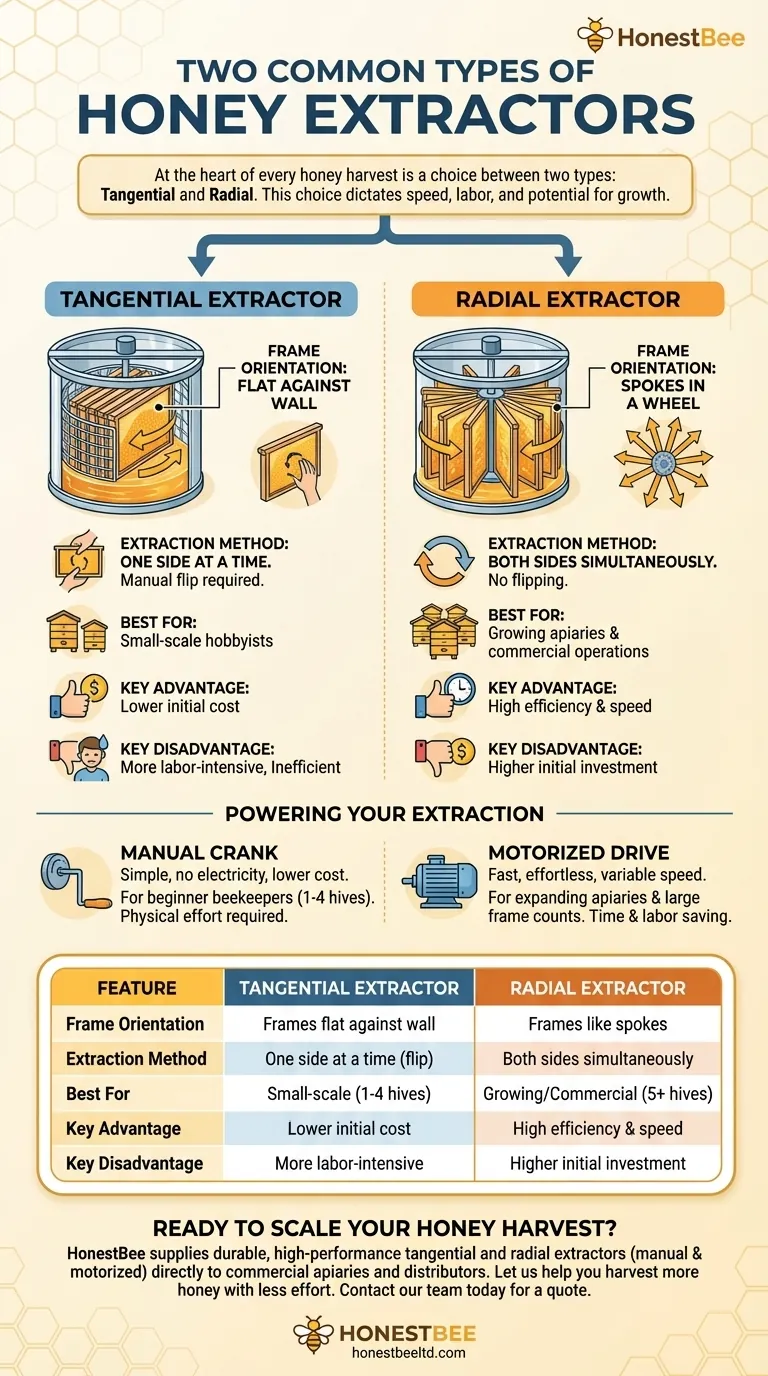At the heart of every honey harvest is a choice between the two common types of honey extractors: tangential and radial. A tangential extractor holds frames against the outside wall, spinning honey from one side at a time, which requires you to flip the frames manually. A radial extractor arranges frames like spokes in a wheel, using centrifugal force to extract honey from both sides simultaneously.
Choosing a honey extractor is not just about the type, but about matching the machine's efficiency to the scale of your beekeeping goals. The core difference lies in how they position the frames, which directly dictates your speed, labor, and potential for growth.

The Core Difference: Frame Orientation and Efficiency
The fundamental distinction between extractor types is how they hold the honey frames inside the drum. This single design choice has significant consequences for the speed and effort of your harvest.
Tangential Extractors: The One-Sided Approach
A tangential extractor places each frame so it sits flat against the inside wall of the drum. As the basket spins, honey is pulled from the outward-facing side of the honeycomb.
Because only one side is extracted at a time, you must stop the process, manually flip each frame, and then spin again to empty the other side. This makes them best suited for beekeepers with only a few hives.
Radial Extractors: The Two-Sided Advantage
A radial extractor positions frames vertically, like spokes extending from the hub of a wheel. The top bar of the frame faces the outer wall of the drum.
When the extractor spins, centrifugal force pulls honey from both sides of the comb at once. This eliminates the need to flip frames, drastically reducing labor and cutting extraction time in half.
Powering Your Extraction: Manual vs. Motorized
Beyond the fundamental design, you must also choose a power source. This decision is closely tied to the number of hives you manage.
The Simplicity of a Manual Crank
Manual extractors use a hand crank to spin the basket. They are simple, require no electricity, and are significantly less expensive.
This makes them an excellent and popular choice for beginner beekeepers or those with a small number of colonies (typically 1-4). The trade-off is the physical effort required.
The Efficiency of a Motorized Drive
Motorized extractors use an electric motor, often with variable speed control, to spin the frames. They are fast, effortless to operate, and essential for processing a large number of frames.
While more expensive, a motor is a crucial investment for any beekeeper looking to expand beyond a few hives, as it saves an immense amount of time and labor.
Understanding the Trade-offs
Your choice of an extractor is a balance between your budget, the time you're willing to spend, and the size of your apiary.
Tangential: Simplicity and Lower Cost
The primary advantage of a tangential extractor is its lower initial cost. Its simple design makes it an accessible entry point for new beekeepers.
However, the major downside is inefficiency. The need to flip every frame adds significant time and labor to your harvest day, a task that becomes overwhelming as your apiary grows. They typically have a smaller capacity, holding only 2 to 6 frames.
Radial: Speed and Scalability
A radial extractor's main benefit is unmatched efficiency. By extracting both sides at once, it dramatically speeds up the process, making it ideal for beekeepers who value their time or plan to expand.
The main trade-off is the higher initial investment. Radial extractors are more complex and thus more expensive. Their capacity can range from a handful of frames to over 100 in large commercial models, making them the standard for serious hobbyists and professional operations.
Making the Right Choice for Your Apiary
Select your extractor based on the current size of your apiary and your goals for the future.
- If your primary focus is a small-scale hobby (1-4 hives): A manual tangential extractor offers the most economical and straightforward starting point.
- If your primary focus is growth and time-saving (5-20+ hives): A motorized radial extractor is the wisest long-term investment for efficient harvesting.
- If your primary focus is commercial production: A large-capacity, stainless steel, motorized radial extractor is the only practical choice.
By understanding these core principles, you can confidently select an extractor that will serve your beekeeping operation effectively for years to come.
Summary Table:
| Feature | Tangential Extractor | Radial Extractor |
|---|---|---|
| Frame Orientation | Frames flat against the drum wall | Frames like spokes in a wheel |
| Extraction Method | One side at a time (flip frames required) | Both sides simultaneously |
| Best For | Small-scale hobbyists (1-4 hives) | Growing apiaries & commercial operations (5+ hives) |
| Key Advantage | Lower initial cost | High efficiency and speed |
| Key Disadvantage | More labor-intensive | Higher initial investment |
Ready to Scale Your Honey Harvest?
Choosing the right extractor is crucial for your operation's efficiency and growth. Whether you're a hobbyist looking to upgrade or a commercial apiary managing hundreds of hives, HONESTBEE has the equipment you need.
We supply durable, high-performance tangential and radial honey extractors—in both manual and motorized models—directly to commercial apiaries and beekeeping equipment distributors through our wholesale-focused operations.
Let us help you harvest more honey with less effort. Contact our team today to discuss your needs and get a quote on the best extractor for your business.
Visual Guide

Related Products
- HONESTBEE 72 Frame Industrial Electric Honey Extractor for Beekeeping
- 6 Frame Manual Stainless Steel Honey Extractor Beekeeping Equipment
- 2 Frame Stainless Steel Manual Honey Spinner Extractor for Beekeeping
- 24 Frame Honey Extractor Commercial Radial Honey Frame Extraction Machine
- Commercial 48-Frame Stainless Steel Honey Extractor
People Also Ask
- What are the advantages of automatic honey extractors? Scale Your Apiary with Unmatched Efficiency
- How is honey harvested from Langstroth hives? A Guide to Efficient, Comb-Preserving Extraction
- What should a beekeeper do after extracting honey from supers? A Guide to Harvest Management
- How do automatic honey extractors function? Achieve High-Efficiency Honey Harvesting
- What are the advantages of automated honey extractors in terms of time efficiency? Boost Your Harvest Speed



















